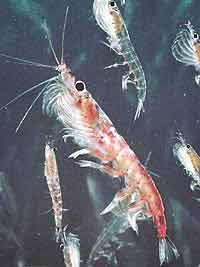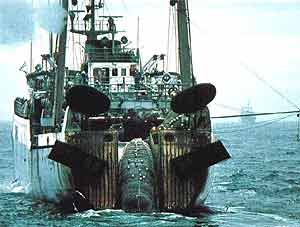by Chalerm Raksanti
Congregating in the millions, krill is an
overwhelmingly important species. The name krill derives from ‘kril’,
an Old Norwegian word once applied to tiny creepy-crawly things, vermin,
and larval fish. Today krill means whale food. A number of species of
euphausiid shrimp, as well as other very small planktonic animals feed the
biggest creatures of all, the great baleen whales. Krill are also
harvested by man and processed into feed for livestock, poultry and farmed
fish. Their swarms constitute the oceans’ richest source of protein.
 Euphausia
supurba
Euphausia
supurba
Euphausia superba is the world’s most abundant
euphausiid and perhaps the most important of all plankton species. E.
superba is the exclusive food of the southern baleen whales, some species
of which are almost pushed to the edge of extinction. Today, because of
the depletion of Antarctic whales, the shrimp that nourished them are much
more numerous than 70 years ago. Experts calculate that the potential
annual yield of this “unutilized whale food” could exceed the present
world harvest of all other edible marine species combined. It is estimated
that 50 to 150 million metric tones of krill (330 billion pounds)
conceivably could be taken by humans each year. That is a shrimp cocktail
the size of a city block and piled five miles high!
Talk of such a harvest alarms marine biologists. Animal
resources historically thought inexhaustible, species like the passenger
pigeon, the bison, and even the great whales themselves, have proved the
most susceptible to over-exploitation or outright extinction.
Although in Antarctic waters the term “krill”
refers specifically to the E. superba, in different areas of the world’s
oceans it designates a variety of animals, depending upon what a
particular species of whale consumes in a certain region. Off Vancouver
Island, krill means the vast shoals of mysid shrimp, the prey of gray
whales. In the Chilean fjords, a thumbnail size pelagic red crab of the
genus Munida, the lobster krill, forms immense swarms and is a favorite
food of sei whales. In the North Atlantic and North Pacific Oceans, krill
includes schooling small fish. But in Antarctic waters, E supurba so
abounds that the baleen whales feed on it almost exclusively.
The planktonic animals called krill congregate in
enormous schools, primarily in polar and sub polar seas. While this
behavior well serves the appetites of whales, such schooling nevertheless
helps protect the crustaceans from other predators such as fish and seals.
Schools of krill, widely scattered, are often simply hard to locate. They
enjoy another built-in advantage; a given predator can only eat so many at
one time.
 Trawler
fishing for krill in Arctic waters
Trawler
fishing for krill in Arctic waters
Still baleen whales can cut a big swath through a mass
of krill. These whales are distinguished from the toothed whales by having
baleen, or whalebone, as part of the mouth structure. Baleen is a material
the consistency of horny fingernails that grows downward from the
whale’s upper jaw. The whale, like a giant pelican, gulps masses of
schooling shrimp and fish. Through the comb-like bristles of its baleen
filters, it squirts out the seawater, entrapping krill by the bushel.
E. superba shrimp have eleven pairs of legs. They swim
with the five posterior pairs, which are broadly paddle-shaped, and they
feed with the six forward pairs. Each feeding leg, split into two
branches, carries stiff bristles and feathery setae. Darting shrimp move
their legs so fast that all an observer will see is a blur.
Euphausiid shrimp are essentially herbivores, eating
diatoms, the single celled plants, or phytoplankton that floats in great
abundance in polar seas. In the sea, the krill schools use their highly
developed sensory receptors to find food. Encountering an enticing taste
or smell, they feed by repeatedly throwing wide their legs to enfold a
packet of seawater that smells edible and contains food. The krill then
squirt the seawater sideways through their setal filters, entrapping algae
in a feeding pattern much like the baleen whales.
In its vast swarms the Antarctic E. superba without
question represents a potential source of food for humans. Dried krill are
more than half protein and are rich in vitamins, especially vitamin A.
Although krill does not enjoy much popularity as a culinary food item on
the kitchen table, krill fisheries will prosper because of a market for
frozen euphausiids to feed trout, salmon, sea bream, red snapper and
yellow-tail in fish farming operations.
As man competes for krill with whales and other marine animals, with
fish and seabirds, serious questions arise. If krill fishery expands, even
the protected southern whales, as their populations attempt to recover,
may not survive. Excessive krill fishing could be disastrous for the
entire fragile Antarctic ecosystem, because almost every animal there
depends on the E. superba, either directly or indirectly, for its
survival.
 Euphausia
supurba
Euphausia
supurba Trawler
fishing for krill in Arctic waters
Trawler
fishing for krill in Arctic waters